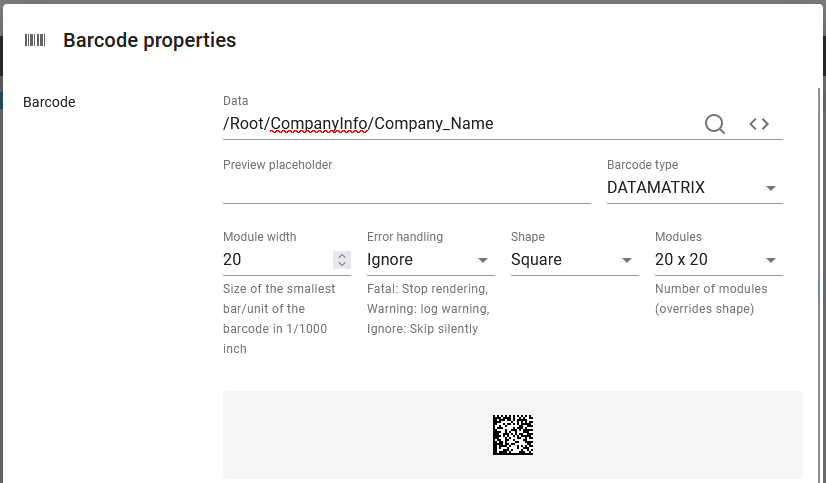If you want to insert a datamatrix barcode in a template, then you need to insert a barcode element.
If you want to insert a Datamatrix GS1 barcode, then you need to setup the data for the barcode accordingly.
You need to select datamatrix as the barcode type, after you have selected the barcode element:

The parameters are:
(The headers are links to the common description).
The data, that you want to put into the barcode. This is normally setup as an Xpath expression to extract data from the input file.
If you want to create the Datamatrix barcode in the GS1 format, then you can do that by starting the data with a vertical pipe "|". This data creates e.g. a GS1 barcode:
|(01)12345678901234(21)123456|(10)ABC123. Please notice, that the character, | is to be used after variable fields only.
If you want to insert a | as the first character in a Datamatrix barcode without triggering the GS1 format, then you need to insert two || characters.
Check out the section, GS1 and EAN barcodes in general for more information and troubleshooting for the GS1 output.
Here you can enter a text constant for the data, that you want to use for the barcode in the result view in the designer.
The width and height of the small squares of the barcode. This is rounded to up to a whole number of dots in the selected output resolution (DPI). For the mime types, ZPL and Direct protocol the resolution/DPI is set on the printer and for PCL/PDF output the resolution is set on the template element in the template.
What to do, if the input data contains unsupported characters.
Shape
Possible values:
Default: InterFormNG2 decides for the optimal shape.
Rectangle: The Datamatrix barcode is always a rectangle.
Square: The barcode is always shaped like a square.
Please notice: The value setup for the shape is ignored, if a specific number of modules has been selected below.
The size of the barcode will be as small as possible (and with the shape specifed above) if the value is blank or default. Alternatively you can select a specific width and height (number of modules in each direction). This sets a fixed sized barcode.